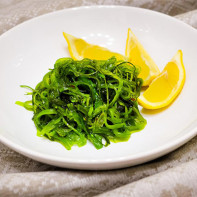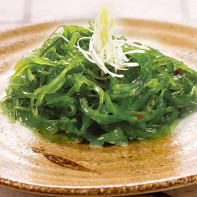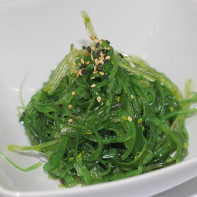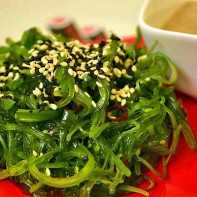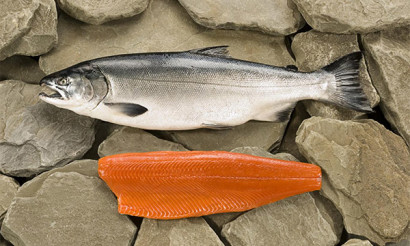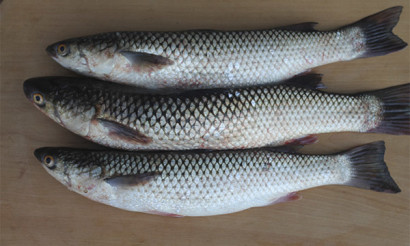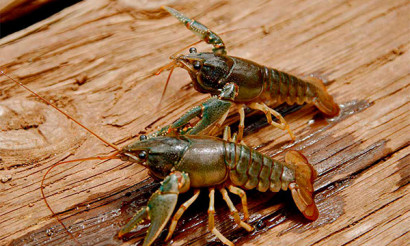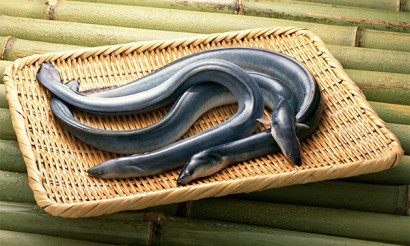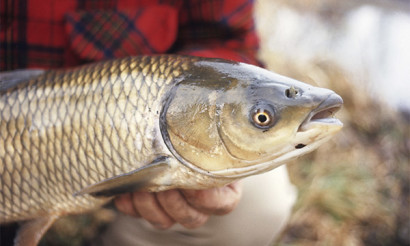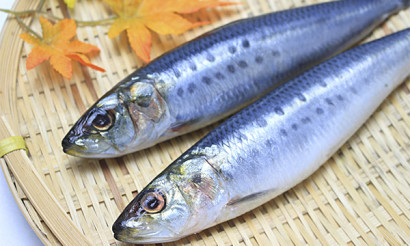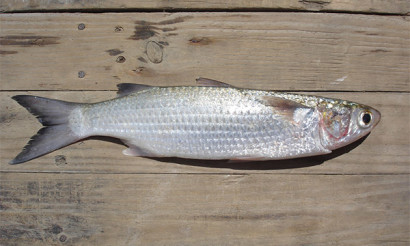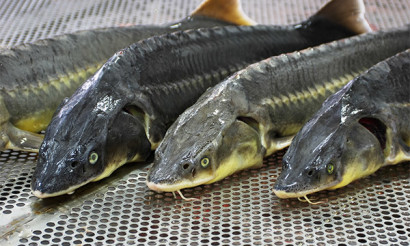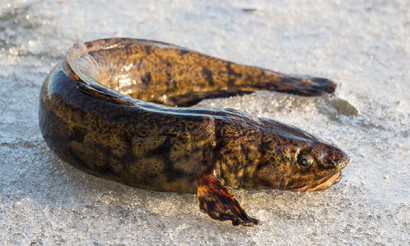Chuka salad: the benefits and harms of seaweed
Chuka is the generalized name for several species of shallow wild edible brown algae that live on underwater rocks off the Far Eastern coast of Russia, Korea, China and Japan. Today, under the influence of man, these types of marine vegetation have spread almost throughout the globe. They can already be found off the coast of Australia, New Zealand, Argentina, USA, UK, as well as Italy and Spain.
- Chinese seaweed from Japan
- Composition and calorie content
- Useful properties of chuck salad
- Is it possible to give chuk salad to pregnant and lactating
- The benefits of chuck salad for weight loss
- Chuka seaweed in medicine
- Harm and contraindications
- How to choose and store chuka algae
- What they eat with: recipes with chuka seaweed
- Walnut Sauce (Gamadari)
- Chuka Salad
- Chuka salad with cucumbers and crab sticks
- Chuka salad with rice
- Kaiso Salad
- Chuck seaweed rolls
- Japanese seaweed soup
- Korean seaweed Miyokkuk soup
Algae are widely used in the traditional national cuisine of the peoples of East Asia due to their good taste and rich content of nutrients. Dishes from them have taken a strong place in the cuisine of many coastal countries. Salads, soups, sushi and rolls are prepared from them.
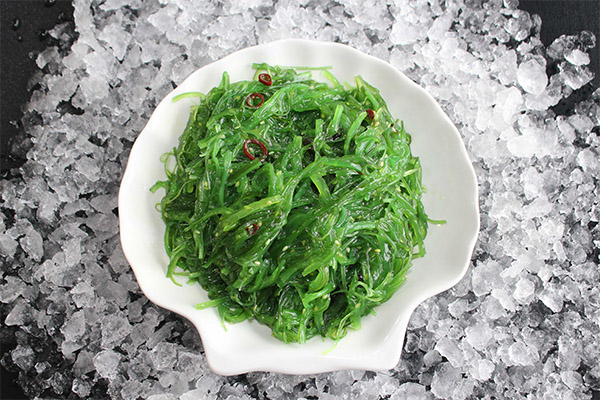
Marine plants contain a large amount of iodine, phytohormones, proteins and trace elements and vitamins necessary for the human body. Eating algae in many nations is considered one of the main sources of health.
Today, an unprecedented popularity around the world has gained a Japanese salad of chuka seaweed. It is included in the menu by people who want to lose weight, build muscle, improve immunity, as well as supporters of vegetarianism. The composition of the salad may vary depending on the place and traditions of preparation, additional ingredients may be included in it, but nevertheless, its basis is made up of incredibly useful chuka seaweed.
Chinese seaweed from Japan
The Russian name for chuka algae is Undaria pinnate (Latin: Undaria pinnatifida), Korean - myek, Japanese - hiyashi wakame.
However, they are better known to the whole world as a “chuka” (tukariari). In literal translation from Japanese, this means "brought from China," "Chinese cuisine." This generic name in Japan is applied to a number of seaweed dishes that are formed in Japanese traditional cuisine based on imported Chinese dishes. But the very essence of such food has changed so much that the Chinese no longer recognize these dishes as theirs. Nevertheless, the name has remained and has become world famous.
Initially, Japan did not have not only its own dishes from chuka algae, but even their trade. Algae was purchased from the Chinese, while also adopting recipes for their preparation.
Despite the use of chuka algae in the culinary of different peoples of the Far East, they were most popular in Japan. Japanese cuisine has long been famous for its careful selection for eating only wholesome foods. This is not surprising: chuka-wakame contain a rich set of trace elements, vitamins, fiber and collagen. In Japan, this product is considered to bestow youth and longevity.
Wakame in large quantities grow on coastal cliffs and are not difficult to prey. In addition, they have a pleasant delicate taste, which distinguishes them from the harsher taste of the well-known kelp.
Today, Wakame algae are harvested commercially in Japan, China, and Korea. In dried and frozen form, the product is supplied worldwide.
Composition and calorie content
Chuka seaweed is a low-calorie product. Per 100 g accounts for 60 to 90 kcal, depending on the specific type of plant and its processing method.
The nutritional value:
- proteins - 1 g;
- fats - 4 g;
- carbohydrates - 12 g.
Almost 80% of the composition of any algae is water. But the remaining 20% is a whole complex of useful components.Chuka seaweed contains such a large list of important nutritional components that it could well replace the intake of pharmaceutical vitamin preparations. So, they include the following trace elements:
- iodine;
- iron
- calcium;
- potassium;
- sodium;
- phosphorus;
- aluminum;
- manganese;
- magnesium;
- zinc;
- fluorine;
- copper;
- selenium.
The vitamin composition of the product is also impressive: vitamins A, B1, B2, B3, B4, B5, B9, C, D, E, K, beta-carotene.
In addition, algae contains unsaturated and polyunsaturated fatty acids (including Omega-3), plant protein, plant enzymes and hormones, dietary fiber, collagen, and the pigment fucoxanthin.
Low calorie content and rich mineral and organic composition make this product indispensable in dietary nutrition. Despite the low calorie content, chuka salad is a very nutritious dish and allows you to saturate the body well with a small amount of consumed kilocalories.
Useful properties of chuck salad
Chuka algae are famous not only for their excellent taste, but also have healing properties. Their regular use in food contributes to the prevention and treatment of various diseases.
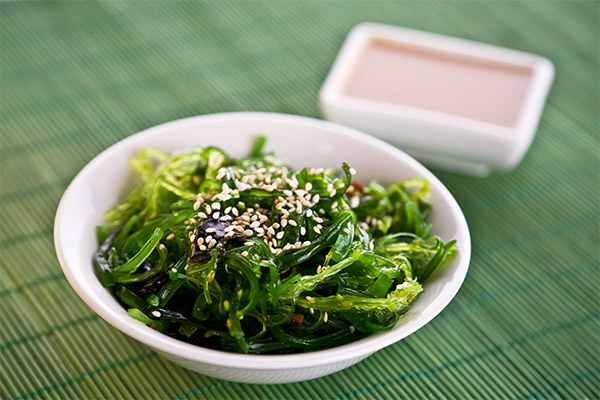
- Like any other seaweed, chuka contains a large amount of iodine. Therefore, the product is very useful for people with thyroid diseases. It is also great for preventing iodine deficiency in the body.
- Vitamin D helps better absorption of phosphorus and calcium, is involved in contractile muscle function, in the functioning of the nervous system, improves skin condition and supports the overall tone of the body.
- Vitamin C helps strengthen teeth and gums, more fully assimilates iron, prevents the development of colds and boosts immunity.
- Vitamin A (retinol) and beta-carotene improve vision, skin condition, stimulate collagen production, participate in protein synthesis, bind and remove free radicals from the body.
- Vitamin E slows down aging, increases the ability of cells to regenerate and form new capillaries, and regulates blood sugar.
- Vitamin K regulates the blood coagulation system, promotes the absorption of proteins and calcium. It participates in the metabolic processes of bone and connective tissues, liver, gall bladder and pancreas, and promotes the breakdown of certain toxins.
- Group B vitamins are involved in the activity of the cardiovascular and nervous systems of the body, help in the absorption of food in the intestines, are involved in cell metabolism and contractile muscle function, increase immunity, and support skin health. These vitamins help you withstand stress and high emotional stress.
- Fiber in the composition of algae has a beneficial effect on intestinal motility and improves digestion. Plant fibers collect and remove from the body various toxins and salts of heavy metals, as well as radionuclides.
- Among other things, this product binds and removes excess cholesterol, thereby preventing the development of atherosclerosis. The minerals that make up its structure strengthen the walls of blood vessels and improve blood microcirculation, which is an excellent prevention of strokes and heart attacks.
- The presence of proteins and amino acids helps to strengthen muscle tissue, including the heart, which makes the product indispensable for athletes and people leading an active lifestyle. Phytohormones help strengthen the cellular structure from the inside, which leads to the ability to resist cancer cells and reduces the risk of cancer.
- The use of chuka algae improves brain function, increases auditory and visual perception, helps to cope with fatigue and stress, stabilizes sleep, improves memory and attention. In people who include these algae in their diet, edema disappears, water-salt metabolism normalizes, and the load on the kidneys decreases.
- The skin condition also improves: epidermal cells are rejuvenated, wrinkles are tightened, wrinkles and stretch marks are smoothed out.Hair follicles are strengthened, hair loss stops and their growth is accelerated. Due to its rich vitamin and mineral composition, the product is a powerful antioxidant.
Chuka algae have been successfully adopted by supporters of vegetarianism. Since they contain most of the vitamins and minerals necessary for the body, as well as proteins, enzymes and hormones.
Is it possible to give chuk salad to pregnant and lactating
Despite the rich composition of vitamins and minerals, as well as healthy iodine, chuka is not recommended during pregnancy. The product contains unsaturated fatty acids and plant hormones that can disrupt the endocrine balance of the body, which, due to pregnancy, undergoes a number of physiological changes.
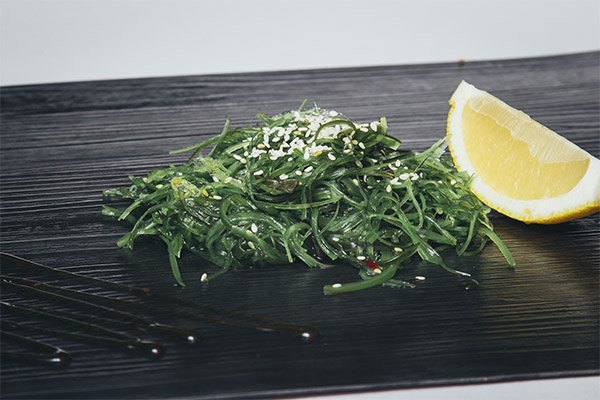
In later pregnancy, the use of chuka seaweed can lead to relaxation of the cervix and premature birth. Also, at all stages of pregnancy, heartburn may occur due to relaxation of the esophageal sphincter.
For the same reasons, one should not get carried away with products from chuka algae and nursing mothers, since all its components, including hormones, can be transmitted through breast milk to the baby and affect its endocrine system. The product is not recommended for children under 12 years old.
However, in Korea, there is a tradition of making soup from these seaweed - myekkuk - for women who have recently given birth. It is believed that such a meal helps to restore strength after childbirth and replenish the reserves of calcium and iodine (although 100 g of the product contains no more than 15% of the daily requirement of the body for calcium). This soup is also traditionally cooked on its birthday (birthday soup), as a reminder of the first person’s meal received with mother’s milk.
The benefits of chuck salad for weight loss
The beneficial properties of the chuka algae described above make it possible to evaluate their positive effect on the whole organism. With regular use of the product (in the absence of contraindications), the metabolism stabilizes, the blood and intestines are cleansed, and vital activity increases. In addition, the product has a low calorie content with such a rich vitamin and mineral composition.
All these factors alone contribute to losing extra pounds. A person has a great need for movement, and the proteins, vitamins and minerals of the marine product more than make up for energy loss.
However, it should be remembered that in the composition of dishes with algae, you do not need to add high-calorie ingredients. Then they will give maximum saturation with a small amount of consumed kilocalories due to the vitamin-mineral complex and fiber.
In addition, chuka algae contains fucoxanthin, a non-vitamin carotenoid pigment. Experiments on rodents showed the ability of this substance to accumulate in fatty tissues and break them down. Based on these results, seaweed producers have begun actively promoting the fat-burning properties of their products. But, unfortunately, there have been almost no studies of this substance in humans, so there is still no sufficient information on this.
Chuka seaweed in medicine
The beneficial properties of brown algae have long been known to residents of coastal countries. Many peoples use them in traditional medicine recipes. Even just the regular use of chuka algae in the daily diet allows you to avoid many different diseases and even recover.

- The Japanese have long considered chuka algae a product that prolongs youth and gives vitality.Therefore, dishes from this marine product are always included in the menu of the elderly. This gives them vitality and slows down age-related changes in the body.
- Chuka seaweed salads are an excellent remedy for vitamin deficiencies, especially in spring, for people of all ages.
- With this amazing marine vegetation, various digestive disorders can be successfully treated, including constipation.
- Brown algae is successfully used for cardiac disorders and cardiovascular diseases. The product helps to tighten the walls of blood vessels and normalize their tone, reduce the risk of atherosclerosis, and also strengthen the heart muscle. As part of complex therapy, this product reduces the risk of heart attack and stroke, improves blood circulation. Effectively its use in anemia.
- The product has taken a strong place in the menu of people with diabetes. Its low glycemic index and a large list of useful substances allow patients with this disease to consume it safely.
- As a medicine, chuka algae is used to treat the mucous membranes of the mouth, stomach, intestines, genitals.
- When bleeding gums use a paste of algae, which is applied to the gums and teeth. At the same time, tooth enamel is strengthened and caries is prevented.
- Dishes from chuka algae are indicated for a weak tone of the lymphatic system. Their regular use improves lymph flow.
- Chuka salad is also able to improve the condition of weakened connective tissues by enriching them with microelements and collagen.
- Algae is considered a product that has a beneficial effect on the reproductive system. It helps women to restore normal blood circulation in the pelvic organs, regulates the menstrual cycle. This is especially true with a sedentary lifestyle or regular weight lifting.
- In Japanese men, this product is considered an aphrodisiac. Scientists of this country argue about its positive effect on the condition of the prostate, on the regulation of potency and sexual desire.
- Chuka algae found their application in cosmetology. Based on their extract, creams and face masks are produced to help fight skin aging. They are also used in their natural form or as part of preparations for wrapping, which are believed to effectively fight cellulite.
Harm and contraindications
Undoubtedly, chuka algae have a wide variety of beneficial properties. But sometimes this wonderful product can be harmful to health instead of good, and this should never be forgotten.

First of all, you need to keep in mind a very important factor: algae, like mushrooms on the ground, easily absorb various foreign, sometimes even toxic, substances from seawater. It is no secret to anyone that today, as a result of human activity, the coastal waters of many seas are often contaminated with harmful, if not dangerous, impurities for human life. And marine plants, like a sponge, absorb everything that is present in water.
If they grew up in an ecologically unfavorable water area, it is difficult to even imagine what harm they can cause to health when eaten: from minor disorders to serious poisoning. Therefore, when buying chuka seaweed in a store, you should choose products only from trusted manufacturers, with a good long-term reputation and positive feedback from experts and consumers.
But even if algae are collected in ecologically clean waters and meet all quality requirements, they should be used with caution by people prone to allergies.You should start with very small portions (no more than one tablespoon) and, if a positive allergic reaction occurs, immediately stop taking the product.
Due to the high iodine content, chuka algae is contraindicated in some disorders of the endocrine system. People with such problems should consult an endocrinologist before using them.
For the same reason, chuka is not recommended for use by children under the age of twelve. In the absence of iodine deficiency in a child, the balance of a still poorly formed hormonal system may be disturbed.
In addition, despite the mass of useful properties, it is not recommended to use them during pregnancy and breastfeeding.
How to choose and store chuka algae
In the natural environment, chuka algae are fleshy leaves that have shades from brown-green to brown. When buying a frozen marine delicacy in a store, you must pay attention to its appearance. It is better to give preference to products in transparent packaging.
The product in the bag should have a fresh saturated color, usually emerald green or with a hint of yellowness. If the product is colorless, or there are lumps of ice and snow in the package, then it is better to refuse to buy and look for another manufacturer. Such things indicate that the contents of the package were thawed and then frozen again, which leads to a decrease in its useful qualities. Thawed seaweed leaves should be soft, delicate, crunchy, with a pleasant taste and rich marine aroma.
In addition, it is useful to find out the place of gathering of marine vegetation and ask about the ecological situation in this region, since algae are a natural filter of sea water and retain various harmful impurities. You can store a frozen product for no more than one year, dry seaweed in its original packaging - no more than two years.
What they eat with: recipes with chuka seaweed
You can eat chuka seaweed as an independent dish, or as a side dish or ingredient for other dishes, fillings for rolls and sushi. If other components are added to the algae, it is worth making sure that they do not interrupt the taste of the main ingredient, and also do not increase the overall calorie content of the dish. It is also necessary to carefully consider the amount of salt so that it does not reduce the taste and useful qualities of the marine delicacy.
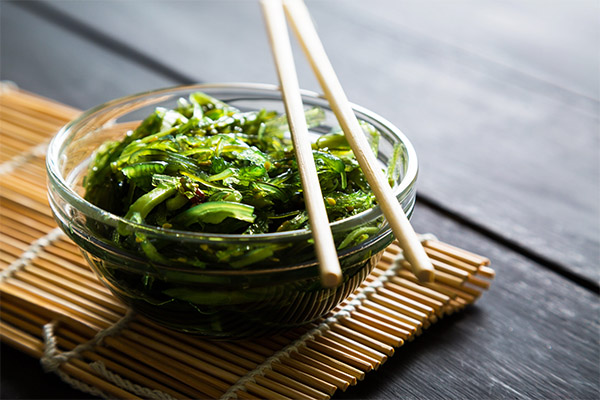
If the algae is frozen, then they should be thawed in air. If the product was sold in dried form, then it must be poured with cold water to swell.
Walnut Sauce (Gamadari)
For the Chuka Japanese salad, peanut sauce is used. For the Kaiso salad, which is close in composition, a thick dressing of soy sauce with sesame seeds, rice vinegar and starch.
Here's a classic recipe for nut sauce. In fact, there are many varieties of it. Cashews and peanuts can be replaced, for example, with walnuts or almonds, lemon juice, mustard, etc. can be included. In the most primitive case, you can use ready-made peanut paste instead of nuts.
Ingredients:
- cashew nuts or peanuts - 100 g;
- water - 100 ml;
- soy sauce - 20 ml;
- sesame seed - 20 g;
- rice or apple vinegar (6%) - 20 ml;
- sesame oil - 10 ml;
- sugar - 1 tsp;
- Mirin (or dry white wine) - 3 tbsp. l
Cooking
Fry nuts and sesame seeds in a dry frying pan until golden brown (do not overcook). Next, they must be ground to a paste-like consistency. You can use a blender or a meat grinder, although they do not give complete grinding. In Japan, it is customary to do this with a mortar.
Next, in a nut paste, you need to add water and cook until thick (approximately to the density of sour cream).Next, remove the paste from the heat and add to it a mixture of soy sauce, vinegar and sesame oil. Add mirin (rice wine), but you can do without it. Mix the sauce thoroughly and leave to cool, then use as a dressing for Chuka salad.
Chuka Salad
Ingredients:
- nut sauce - 3-4 tbsp .;
- Chuka seaweed - 250 g;
- lemon juice (freshly squeezed) - 1 tsp;
- sesame seed - 1.5 tbsp .;
- hot red pepper to taste.
Cooking
Sesame seed fry in a dry frying pan until golden brown.
To the prepared algae (thawed or soaked) add thin rings of hot pepper. Season it all with peanut sauce, lemon juice and sprinkle with fried sesame seeds.
Chuka salad with cucumbers and crab sticks
Ingredients:
- Chuka seaweed - 250 g;
- fresh cucumbers - 250 g;
- crab sticks - 250 g.
- sesame seed - 1 tablespoon;
- peanut sauce.
Cooking
Thaw or soak chuka seaweed. Cut cucumbers and crab sticks into thin strips (like seaweed). Mix all ingredients, season with peanut sauce and sprinkle with fried sesame seed on top.
Chuka salad with rice
Ingredients:
- Chuka seaweed - 300 g;
- eggs - 3 pcs.;
- rice - 1 cup;
- vegetable oil - 1 tsp;
- sesame seed - 1 tbsp;
- soy sauce - to taste.
Cooking
Fry the eggs in a pan with vegetable oil, stirring constantly to make a friable omelet. Boil rice over low heat. Mix seaweed (they can be cut), omelet and rice. Season the salad with peanut sauce and sprinkle with fried sesame seeds.
Kaiso Salad
This salad also exists in many varieties. It may include celery, pickled cherries, daikon and other vegetables. Sometimes dry algae are used for Kaiso salad, and dry algae are used, and without preliminary soaking, they are softened during pickling due to the liquid from the dressing.
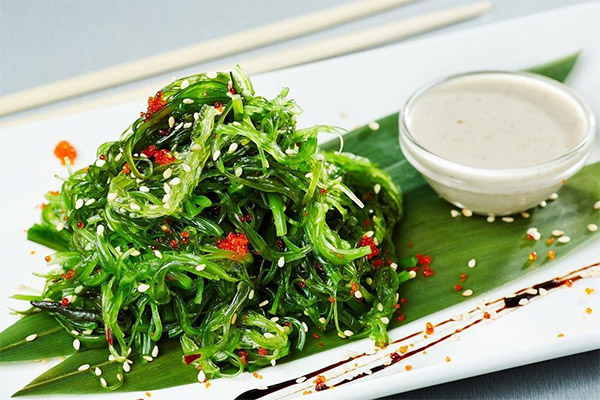
Ingredients:
- Chuka seaweed - 250 g;
- water - 50 ml;
- sesame oil - 1 tsp;
- soy sauce - 50 ml;
- sesame seed - 1.5 tbsp .;
- starch - 1/3 tablespoon;
- lemon juice (freshly squeezed) or rice vinegar - 1 tsp;
- fresh hot red pepper to taste.
Cooking
Sesame seed fry in a dry frying pan until golden brown.
Soy sauce and half the norm of water mix and bring to a boil, then add the starch diluted with the remaining water and heat further until thickened. Then remove the sauce from the heat and add lemon juice or vinegar, as well as sesame oil. If desired, add thin slices of hot pepper.
Season the seaweed with the cooled sauce and sprinkle with fried sesame seeds. Leave the marinating salad for 1–2 hours.
Chuck seaweed rolls
Ingredients:
- Chuka seaweed - 200 g;
- rice - 1.5 cups;
- rice vinegar - 100 ml;
- nori - 4 leaves;
- sesame seeds - 2 tablespoons;
- soy sauce, gari (pickled ginger), wasabi - to taste.
Cooking
Boil the rice until soft, add rice vinegar to it. Mix gently so that the rice does not stick together in a continuous mass.
Lay the nori sheet on the mat with the smooth side down and distribute the rice on its surface, departing 1.5–2 cm from the free edge. Moisten the free edge of nori with water. Closer to the front edge of the roll lay the algae and roll the nori tightly. With a sharp knife, cut it into 6-8 parts, lay them on a plate with the slices up and sprinkle with fried sesame seeds.
Japanese seaweed soup
For this soup, you need to separately prepare mushroom or vegetable broth. When ready, mushrooms and vegetables are removed from the broth, and the broth itself is used as the basis for the soup.
Ingredients:
- dried chuka seaweed - 20 g;
- thin rice noodles - 50 g;
- sesame oil - 1 tbsp;
- ginger grated - 1 tbsp .;
- garlic - 2 cloves;
- black and red pepper, salt - to taste.
For broth
200 g of mushrooms (champignons or any other) or 500 g of vegetables (onions, carrots, celery).
Cooking
Cook mushroom or vegetable broth, season it with salt and pepper. Separately, gently fry the grated carrots in sesame oil with the addition of grated ginger and garlic. Put the vegetables in a saucepan, pour boiling broth and bring to a boil. After boiling add dry Wakame seaweed and cook for no more than 10 minutes. You can use already soaked algae or thawed. Three minutes before the end of cooking add rice noodles. The noodles can be boiled separately and served in a cup, pouring it with broth with seaweed. Move the prepared soup from the heat and, if necessary, add paprika and salt. The soup should be infused under the lid for 10-15 minutes, after which it can be served.
Korean seaweed Miyokkuk soup
This soup in Korea is considered a birthday soup. Mothers cook it for their children on their birthday. For soup, you can use not only chuka seaweed, but also seaweed - kelp.
Ingredients:
- dried seaweed - 70 g;
- beef on the bone - 250 g;
- garlic - 3 cloves;
- small onion - 1 pc.;
- soy sauce - 2 tbsp .;
- fish sauce - 2 tbsp .;
- salt to taste.
Cooking
Put the beef in cold water and bring to a boil. After this, drain the broth, and pour the meat with fresh water and cook until cooked. After that, pre-soaked or thawed seaweed should be added to the soup. After the soup boils again, you need to add spices to it: soy sauce, garlic, onions, salt and fish sauce. Then cook over low heat under a lid for another 15–20 minutes. Serve in a separate cup for boiled rice.
«Important: all information on the site is provided exclusively in fact-finding purposes. Before applying any recommendations, consult with a profile specialist. Neither the editors nor the authors are liable for any possible harm caused materials. "

